Sub-5 nm Gate-Length Monolayer Selenene Transistors
Abstract
1. Introduction
2. Result and Discussion
2.1. Device Structure
2.2. On-State Current
2.3. Gate Controlling Ability
2.4. τ, PDP and EDP
2.5. Discussion
3. Model and Approach
4. Conclusions
Supplementary Materials
Author Contributions
Funding
Institutional Review Board Statement
Informed Consent Statement
Data Availability Statement
Acknowledgments
Conflicts of Interest
Sample Availability
References
- Moore, G.E. Cramming more components onto integrated circuits. Electronics 1965, 38, 114–117. [Google Scholar] [CrossRef]
- Lundstrom, M. Moore’s law forever? Science 2003, 299, 210–211. [Google Scholar] [CrossRef] [PubMed]
- Packan, P.A. Pushing the limits. Science 1999, 285, 2079–2081. [Google Scholar] [CrossRef]
- Dennard, R.H.; Gaensslen, F.H.; Yu, H.N.; Rideout, V.L.; Bassous, E.; LeBlanc, A.R. Design of ion-implanted MOSFET’s with very small physical dimensions. IEEE J. Solid State Circuits 1974, 9, 256–268. [Google Scholar] [CrossRef]
- Chhowalla, M.; Jena, D.; Zhang, H. Two-dimensional semiconductors for transistors. Nat. Rev. Mater. 2016, 1, 16052. [Google Scholar] [CrossRef]
- Glavin, N.R.; Rao, R.; Varshney, V.; Bianco, E.; Apte, A.; Roy, A.; Ringe, E.; Ajayan, P.M. Emerging Applications of Elemental 2D Materials. Adv. Mater. 2020, 32, 1904302. [Google Scholar] [CrossRef]
- Tao, W.; Kong, N.; Ji, X.; Zhang, Y.; Sharma, A.; Ouyang, J.; Qi, B.; Wang, J.; Xie, N.; Kang, C.; et al. Emerging two-dimensional monoelemental materials (Xenes) for biomedical applications. Chem. Soc. Rev. 2019, 48, 2891–2912. [Google Scholar] [CrossRef]
- Li, Q.; Xu, L.; Liu, S.; Yang, J.; Fang, S.; Li, Y.; Ma, J.; Zhang, Z.; Quhe, R.; Yang, J.; et al. Bilayer tellurene: A potential p-type channel material for sub-10 nm transistors. Adv. Theory Simul. 2021, 4, 2000252. [Google Scholar] [CrossRef]
- Yan, J.; Pang, H.; Xu, L.; Yang, J.; Quhe, R.; Zhang, X.; Pan, Y.; Shi, B.; Liu, S.; Xu, L.; et al. Excellent device performance of sub-5-nm monolayer tellurene transistors. Adv. Electron. Mater. 2019, 5, 1900226. [Google Scholar] [CrossRef]
- Li, L.; Yu, Y.; Ye, G.J.; Ge, Q.; Ou, X.; Wu, H.; Feng, D.; Chen, X.H.; Zhang, Y. Black phosphorus field-effect transistors. Nat. Nanotechnol. 2014, 9, 372–377. [Google Scholar] [CrossRef]
- Xie, Z.; Zhang, B.; Ge, Y.; Zhu, Y.; Nie, G.; Song, Y.; Lim, C.-K.; Zhang, H.; Prasad, P.N. Chemistry, Functionalization, and Applications of Recent Monoelemental Two-Dimensional Materials and Their Heterostructures. Chem. Rev. 2022, 122, 1127–1207. [Google Scholar] [CrossRef] [PubMed]
- Li, H.; Tie, J.; Li, J.; Ye, M.; Zhang, H.; Zhang, X.; Pan, Y.; Wang, Y.; Quhe, R.; Pan, F.; et al. High-performance sub-10-nm monolayer black phosphorene tunneling transistors. Nano Res. 2018, 11, 2658–2668. [Google Scholar] [CrossRef]
- Qiu, C.; Zhang, Z.; Xiao, M.; Yang, Y.; Zhong, D.; Peng, L.-M. Scaling carbon nanotube complementary transistors to 5-nm gate lengths. Science 2017, 355, 271–276. [Google Scholar] [CrossRef] [PubMed]
- Quhe, R.; Li, Q.; Zhang, Q.; Wang, Y.; Zhang, H.; Li, J.; Zhang, X.; Chen, D.; Liu, K.; Ye, Y.; et al. Simulations of quantum transport in sub-5-nm monolayer phosphorene transistors. Phys. Rev. Appl. 2018, 10, 024022. [Google Scholar] [CrossRef]
- Pan, Y.; Dai, J.; Xu, L.; Yang, J.; Zhang, X.; Yan, J.; Li, J.; Shi, B.; Liu, S.; Hu, H.; et al. Sub-5-nm monolayer silicane transistor: A first-principles quantum transport simulation. Phys. Rev. Appl. 2020, 14, 024016. [Google Scholar] [CrossRef]
- Grazianetti, C.; Martella, C.; Molle, A. The Xenes Generations: A Taxonomy of Epitaxial Single-Element 2D Materials. Phys. Status Solidi (RRL)—Rapid Res. Lett. 2020, 14, 1900439. [Google Scholar] [CrossRef]
- Qin, J.; Qiu, G.; Jian, J.; Zhou, H.; Yang, L.; Charnas, A.; Zemlyanov, D.Y.; Xu, C.-Y.; Xu, X.; Wu, W.; et al. Controlled Growth of a Large-Size 2D Selenium Nanosheet and Its Electronic and Optoelectronic Applications. ACS Nano 2017, 11, 10222–10229. [Google Scholar] [CrossRef]
- Ren, L.; Zhang, H.; Tan, P.; Chen, Y.; Zhang, Z.; Chang, Y.; Xu, J.; Yang, F.; Yu, D. Hexagonal Selenium Nanowires Synthesized via Vapor-Phase Growth. J. Phys. Chem. B 2004, 108, 4627–4630. [Google Scholar] [CrossRef]
- Singh, J.; Jamdagni, P.; Jakhar, M.; Kumar, A. Stability, electronic and mechanical properties of chalcogen (Se and Te) monolayers. Phys. Chem. Chem. Phys. 2020, 22, 5749–5755. [Google Scholar] [CrossRef]
- Hu, A.-M.; Zhang, X.-H.; Xiao, W.-Z.; Meng, B. Structural, electronic, and optic properties of Se nanotubes. Phys. B Condens. Matter 2022, 624, 413417. [Google Scholar] [CrossRef]
- Li, Q.; Tan, X.; Yang, Y. Sub-5 nm Gate Length Selenium Nanowire Transistors: Implications for Nanoelectronics. ACS Appl. Nano Mater. 2023, 6, 4067–4077. [Google Scholar] [CrossRef]
- Lin, C.; Cheng, W.; Chai, G.; Zhang, H. Thermoelectric properties of two-dimensional selenene and tellurene from group-VI elements. Phys. Chem. Chem. Phys. 2018, 20, 24250–24256. [Google Scholar] [CrossRef] [PubMed]
- Liu, G.; Gao, Z.; Li, G.-L.; Wang, H. Abnormally low thermal conductivity of 2D selenene: An ab initio study. J. Appl. Phys. 2020, 127, 065103. [Google Scholar] [CrossRef]
- QuantumATK Version P-2019.03. Available online: https://www.synopsys.com/silicon/quantumatk.html (accessed on 1 April 2019).
- Min, J.; Zhao, C.; Zeng, Z.; Jia, Y.; Du, Z. Tunable visible-light excitonic absorption and high photoconversion efficiency in two-dimensional group-VI monolayer materials. Phys. Rev. B 2019, 100, 085402. [Google Scholar] [CrossRef]
- Smidstrup, S.; Markussen, T.; Vancraeyveld, P.; Wellendorff, J.; Schneider, J.; Gunst, T.; Verstichel, B.; Stradi, D.; Khomyakov, P.A.; Vej-Hansen, U.G.; et al. QuantumATK: An integrated platform of electronic and atomic-scale modelling tools. J. Phys. Condens. Matter 2019, 32, 015901. [Google Scholar] [CrossRef]
- Datta, S. Quantum Transport: Atom to Transistor; Cambridge University Press: Cambridge, UK, 2005. [Google Scholar]
- Quhe, R.; Liu, S.; Yang, C.; Wang, Y.; Li, H.; Yang, J.; Li, Q.; Shi, B.; Li, Y.; Pan, Y.; et al. Sub-10 nm two-dimensional transistors: Theory and experiment. Phys. Rep. 2021, 938, 1–72. [Google Scholar] [CrossRef]
- Cao, W.; Kang, J.; Sarkar, D.; Liu, W.; Banerjee, K. 2D semiconductor FETs-projections and design for sub-10 nm VLSI. IEEE Trans. Electron Devices 2015, 62, 3459–3469. [Google Scholar] [CrossRef]
- Zhang, H.; Shi, B.; Xu, L.; Yan, J.; Zhao, W.; Zhang, Z.; Zhang, Z.; Lu, J. Sub-5 nm monolayer MoS2 transistors toward low-power devices. ACS Appl. Electron. Mater. 2021, 3, 1560–1571. [Google Scholar] [CrossRef]
- Wang, Y.; Fei, R.; Quhe, R.; Li, J.; Zhang, H.; Zhang, X.; Shi, B.; Xiao, L.; Song, Z.; Yang, J.; et al. Many-body effect and device performance limit of monolayer InSe. ACS Appl. Mater. Interfaces 2018, 10, 23344–23352. [Google Scholar] [CrossRef]
- Quhe, R.; Liu, J.; Wu, J.; Yang, J.; Wang, Y.; Li, Q.; Li, T.; Guo, Y.; Yang, J.; Peng, H.; et al. High-performance sub-10 nm monolayer Bi2O2Se transistors. Nanoscale 2019, 11, 532–540. [Google Scholar] [CrossRef]
- Yang, J.; Quhe, R.; Li, Q.; Liu, S.; Xu, L.; Pan, Y.; Zhang, H.; Zhang, X.; Li, J.; Yan, J.; et al. Sub 10 nm bilayer Bi2O2Se transistors. Adv. Electron. Mater. 2019, 5, 1800720. [Google Scholar] [CrossRef]
- Meng, Y.-X.; Zhao, Y.-F.; Li, S.-C. Research progress of puckered honeycomb monolayers. Acta Phys. Sin. 2021, 70, 148101-1–148101-18. [Google Scholar] [CrossRef]
- Chen, P.; Li, N.; Chen, X.; Ong, W.-J.; Zhao, X. The rising star of 2D black phosphorus beyond graphene: Synthesis, properties and electronic applications. 2D Mater. 2018, 5, 014002. [Google Scholar] [CrossRef]
- Qu, H.; Guo, S.; Zhou, W.; Wu, Z.; Cao, J.; Li, Z.; Zeng, H.; Zhang, S. Enhanced interband tunneling in two-dimensional tunneling transistors through anisotropic energy dispersion. Phys. Rev. B 2022, 105, 075413. [Google Scholar] [CrossRef]
- Jiang, C.; Si, M.; Liang, R.; Xu, J.; Ye, P.D.; Alam, M.A. A closed form analytical model of back-gated 2-D semiconductor negative capacitance field effect transistors. IEEE J. Electron Devices Soc. 2018, 6, 189–194. [Google Scholar] [CrossRef]
- Starkov, A.; Starkov, I. Asymptotic description of the time and temperature hysteresis in the framework of Landau-Khalatnikov equation. Ferroelectrics 2014, 461, 50–60. [Google Scholar] [CrossRef]
- Xu, P.; Liang, J.; Li, H.; Liu, F.; Tie, J.; Jiao, Z.; Luo, J.; Lu, J. Device performance limits and negative capacitance of monolayer GeSe and GeTe tunneling field effect transistors. RSC Adv. 2020, 10, 16071–16078. [Google Scholar] [CrossRef]
- Brandbyge, M.; Mozos, J.-L.; Ordejón, P.; Taylor, J.; Stokbro, K. Density-functional method for nonequilibrium electron transport. Phys. Rev. B 2002, 65, 165401. [Google Scholar] [CrossRef]
- Datta, S. Electronic Transport in Mesoscopic Systems; Cambridge University Press: Cambridge, UK, 1995. [Google Scholar]
- Smidstrup, S.; Stradi, D.; Wellendorff, J.; Khomyakov, P.A.; Vej-Hansen, U.G.; Lee, M.E.; Ghosh, T.; Jónsson, E.; Jónsson, H.; Stokbro, K. First-principles Green’s-function method for surface calculations: A pseudopotential localized basis set approach. Phys. Rev. B 2017, 96, 195309. [Google Scholar] [CrossRef]
- Stradi, D.; Martinez, U.; Blom, A.; Brandbyge, M.; Stokbro, K. General atomistic approach for modeling metal-semiconductor interfaces using density functional theory and nonequilibrium Green’s function. Phys. Rev. B 2016, 93, 155302. [Google Scholar] [CrossRef]
- Perdew, J.P.; Burke, K.; Ernzerhof, M. Generalized gradient approximation made simple. Phys. Rev. Lett. 1996, 77, 3865–3868. [Google Scholar] [CrossRef] [PubMed]
- Gao, S.; Yang, L. Renormalization of the quasiparticle band gap in doped two-dimensional materials from many-body calculations. Phys. Rev. B 2017, 96, 155410. [Google Scholar] [CrossRef]
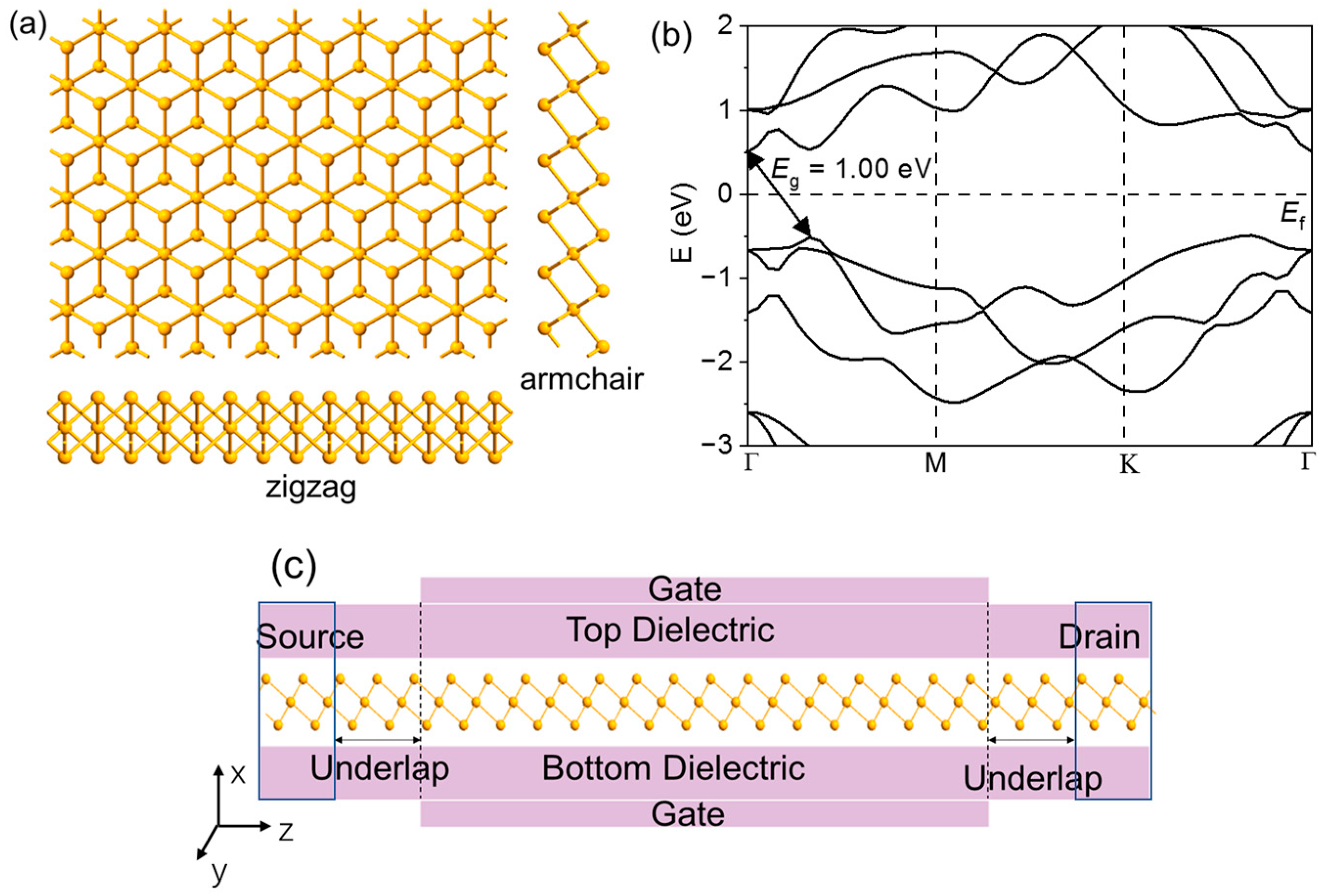

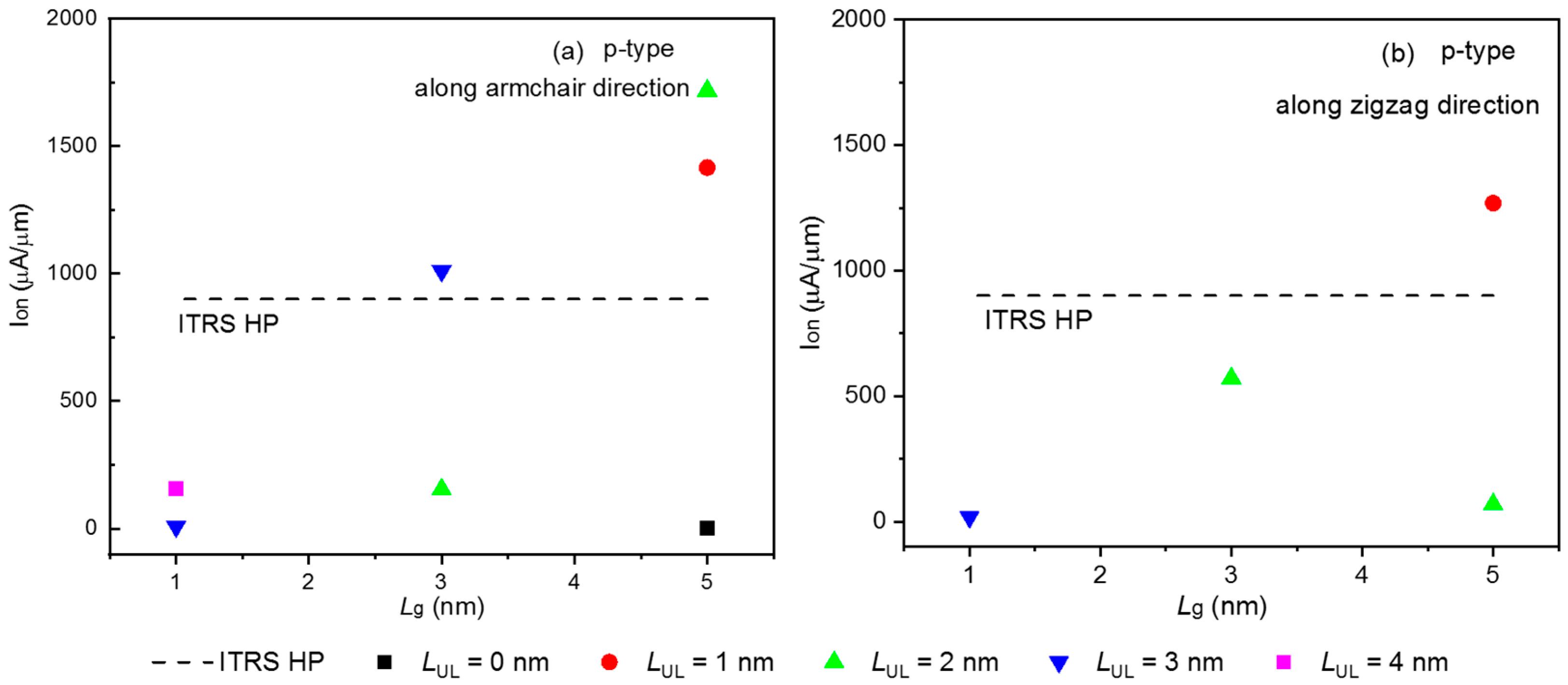

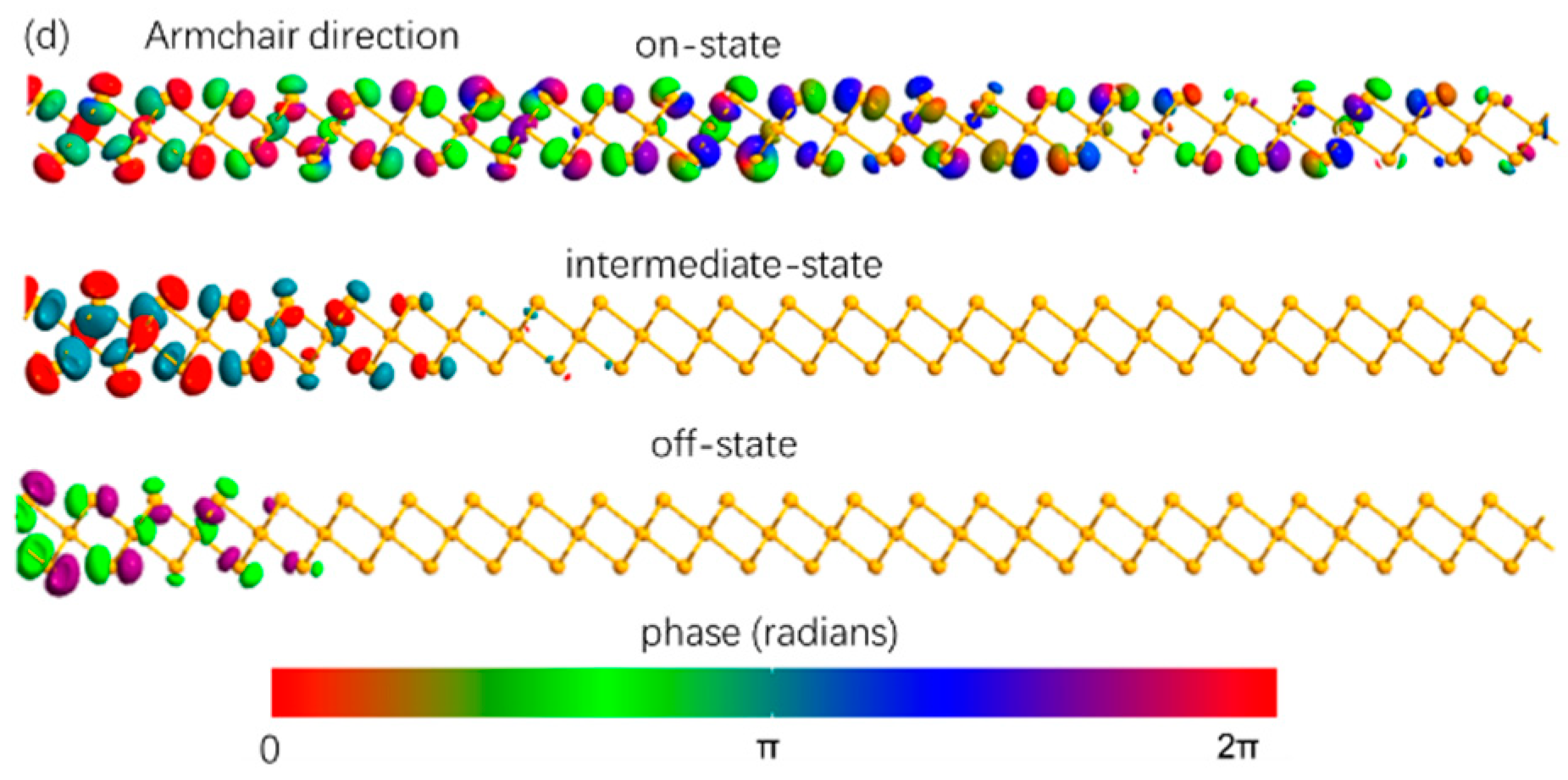
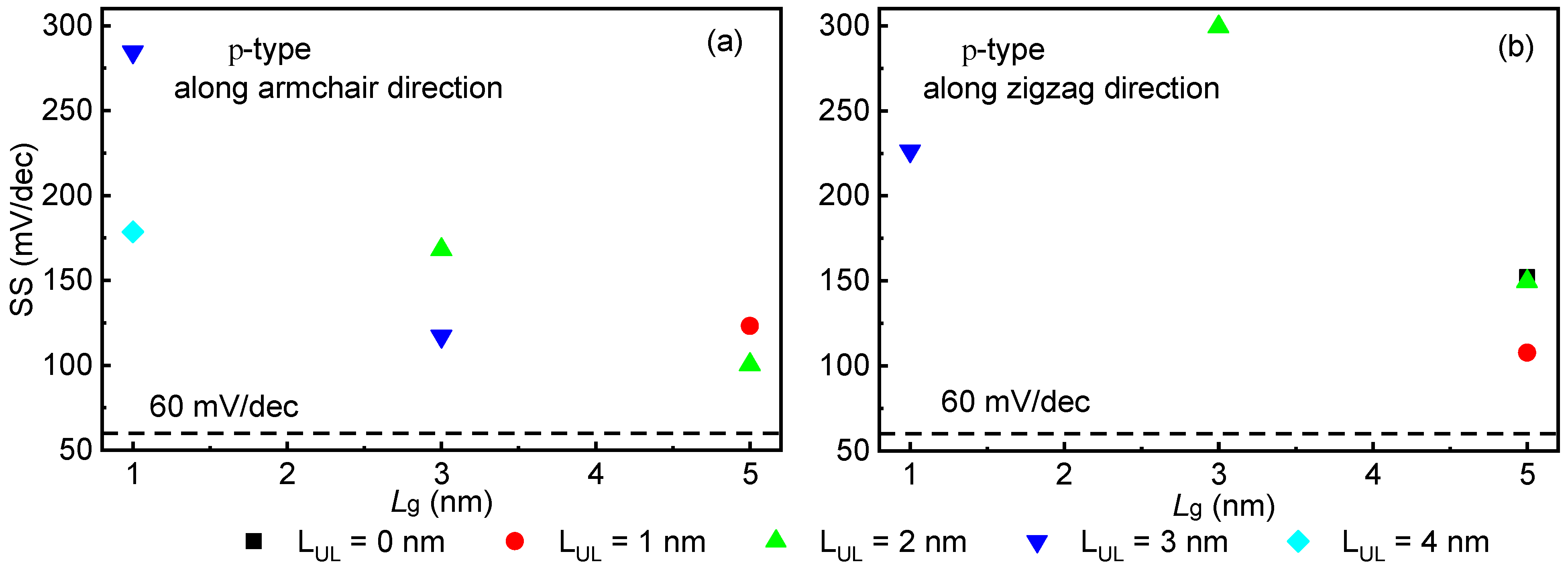

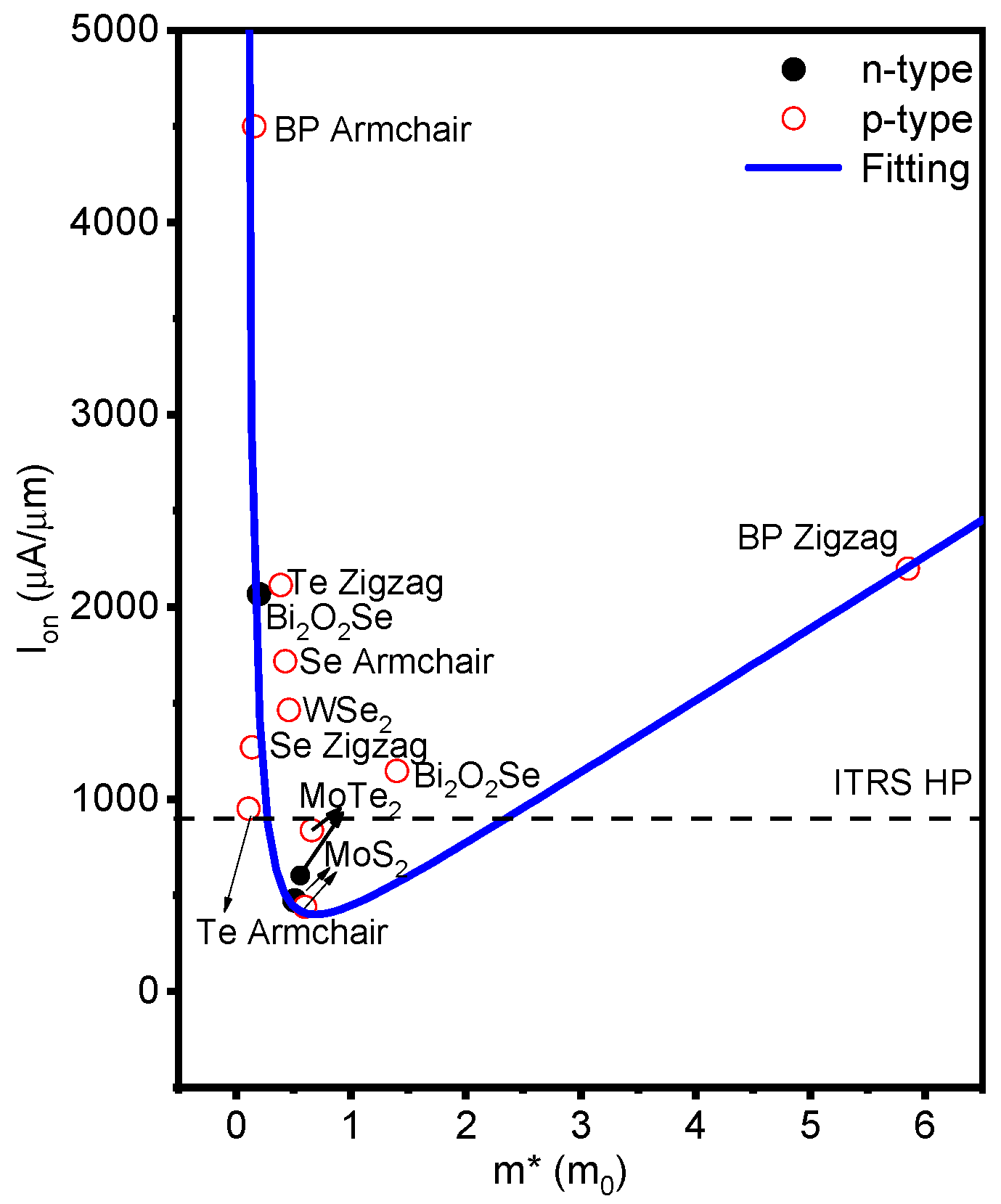
| Lg (nm) | LUL (nm) | SS (mV/dec) | Ioff (µA/µm) | Ion (µA/µm) | Ion/Ioff | Ct | τ (ps) | PDP | |
|---|---|---|---|---|---|---|---|---|---|
| (fF/µm) | (fJ/µm) | ||||||||
| p-type | 5 | 0 | - | 0.1 | 0.38 | - | - | - | - |
| HP | 1 | 123.18 | 0.1 | 1416.15 | 1.42 × 104 | 0.46 | 0.21 | 0.19 | |
| 2 | 100.39 | 0.1 | 1717.81 | 1.72 × 104 | 0.41 | 0.15 | 0.17 | ||
| 3 | 0 | - | 0.1 | - | - | - | - | - | |
| 1 | - | 0.1 | - | - | - | - | - | ||
| 2 | 168.15 | 0.1 | 153.80 | 1.54 × 103 | 0.29 | 1.22 | 0.12 | ||
| 3 | 117.19 | 0.1 | 1010.32 | 1.01 × 104 | 0.24 | 0.15 | 0.10 | ||
| 1 | 0 | - | 0.1 | - | - | - | - | - | |
| 1 | - | 0.1 | - | - | - | - | - | ||
| 2 | - | 0.1 | - | - | - | - | - | ||
| 3 | 284.49 | 0.1 | 7.86 | 7.86 × 101 | 0.13 | 10.41 | 0.05 | ||
| 4 | 178.68 | 0.1 | 157.96 | 1.58 × 103 | 0.12 | 0.47 | 0.05 | ||
| ITRS HP 2028 | 5.1 | - | - | 0.1 | 900 | 9.00 × 103 | 0.6 | 0.423 | 0.24 |
| Lg (nm) | LUL (nm) | SS (mV/dec) | Ioff (µA/µm) | Ion (µA/µm) | Ion/Ioff | Ct | τ (ps) | PDP | |
|---|---|---|---|---|---|---|---|---|---|
| (fF/µm) | (fJ/µm) | ||||||||
| p-type | 5 | 0 | 152.09 | 0.1 | - | - | |||
| HP | 1 | 107.77 | 0.1 | 1269.00 | 1.27 × 104 | 0.68 | 0.34 | 0.28 | |
| 2 | 149.67 | 0.1 | 69.20 | 6.92 × 102 | 0.92 | 8.51 | 0.38 | ||
| 3 | 0 | 0.1 | - | - | |||||
| 1 | 0.1 | - | - | ||||||
| 2 | 299.46 | 0.1 | 571.02 | 5.71 × 103 | 0.74 | 0.83 | 0.30 | ||
| 3 | 0.1 | - | - | ||||||
| 1 | 0 | - | 0.1 | - | - | - | - | - | |
| 1 | - | 0.1 | - | - | - | - | - | ||
| 2 | - | 0.1 | - | - | - | - | - | ||
| 3 | 226.47 | 0.1 | 17.06 | 1.71 × 102 | 0.20 | 7.67 | 0.08 | ||
| 4 | - | 0.1 | - | - | |||||
| ITRS HP 2028 | 5.1 | - | - | 0.1 | 900 | 9.00 × 103 | 0.6 | 0.423 | 0.24 |
Disclaimer/Publisher’s Note: The statements, opinions and data contained in all publications are solely those of the individual author(s) and contributor(s) and not of MDPI and/or the editor(s). MDPI and/or the editor(s) disclaim responsibility for any injury to people or property resulting from any ideas, methods, instructions or products referred to in the content. |
© 2023 by the authors. Licensee MDPI, Basel, Switzerland. This article is an open access article distributed under the terms and conditions of the Creative Commons Attribution (CC BY) license (https://creativecommons.org/licenses/by/4.0/).
Share and Cite
Li, Q.; Tan, X.; Yang, Y.; Xiong, X.; Zhang, T.; Weng, Z. Sub-5 nm Gate-Length Monolayer Selenene Transistors. Molecules 2023, 28, 5390. https://doi.org/10.3390/molecules28145390
Li Q, Tan X, Yang Y, Xiong X, Zhang T, Weng Z. Sub-5 nm Gate-Length Monolayer Selenene Transistors. Molecules. 2023; 28(14):5390. https://doi.org/10.3390/molecules28145390
Chicago/Turabian StyleLi, Qiang, Xingyi Tan, Yongming Yang, Xiaoyong Xiong, Teng Zhang, and Zhulin Weng. 2023. "Sub-5 nm Gate-Length Monolayer Selenene Transistors" Molecules 28, no. 14: 5390. https://doi.org/10.3390/molecules28145390
APA StyleLi, Q., Tan, X., Yang, Y., Xiong, X., Zhang, T., & Weng, Z. (2023). Sub-5 nm Gate-Length Monolayer Selenene Transistors. Molecules, 28(14), 5390. https://doi.org/10.3390/molecules28145390






